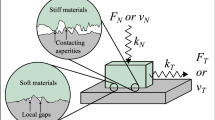Abstract
Although, a lot is known about the factors contributing to friction, a complete physical understanding of the origins of friction is still lacking. At the macroscale several laws have long since described the relation between load (Amontons, Coulomb), apparent and real area of contact (Bowden and Tabor), and frictional forces. But it is not yet completely understood if these laws of friction extend all the way down to the atomistic level. Some current research suggests that a linear dependence of friction on the real contact area is observed at the atomistic level, but only for specific cases (indentors and rigid substrates). Because continuum models are not applicable at the atomic scale, other modeling techniques (such as molecular dynamics simulations) are necessary to elucidate the physics of friction at the small scale. We use molecular dynamics simulations to model the friction of two rough deformable surfaces, while changing the surface roughness, the sliding speed, and the applied normal load. We find that friction increases with roughness. Also all sliding cases show considerable surface flattening, reducing the friction close to zero after repetitive sliding. This questions the current view of (static) roughness at the atomistic scale, and possibly indicates that the macroscopic laws of friction break down several orders of magnitude before reaching the atomic scale.





Similar content being viewed by others
References
Bowden, F.P., Tabor, D.: The Friction and Lubrication of Solids. Oxford University Press, Oxford, United Kingdom (2001)
Blau, P.J.: The significance and use of the friction coefficient. Tribol. Int. 34, 585–591 (2001)
Johnson, K.L.: Contact Mechanics. Cambridge University Press, Cambridge (1985)
Archard, J.F.: Contact and rubbing of flat surfaces. J. Appl. Phys. 24, 981–988 (1953)
Greenwood, J.A., Williamson, J.B.P.: Contact of nominally flat surfaces. Proc. R. Soc. Lond. A 295, 300–319 (1966)
Persson, B.N.J., Albohr, O., Tartaglino, U., Volokitin, A.I., Tosatti, E.: On the nature of surface roughness with application to contact mechanics, sealing, rubber friction and adhesion. J. Phys. Condens. Matter 17, R1–R62 (2005)
Luan, B., Robbins, M.O.: The breakdown of continuum models for mechanical contacts. Nature 435, 929–932 (2005)
Luan, B., Robbins, M.O.: Contact of single asperities with varying adhesion: comparing continuum mechanics to atomistic simulations. Phys. Rev. E 74, 026111 (2006)
Sørensen, M.R., Jacobsen, K.W., Stoltze, P.: Simulations of atomic-scale sliding friction. Phys. Rev. B 53, 2101–2113 (1996)
Buldum, A., Ciraci, S., Batra, I.P.: Contact, nanoindentation, and sliding friction. Phys. Rev. B 57, 2468–2476 (1998)
Knippenberg, M.T., Mikulski, P.T., Dunlap, B.I., Harrison, J.A.: Atomic contributions to friction and load for tip-self-assembled monolayers interactions. Phys. Rev. B 78, 235409 (2008)
Mo, Y., Turner, K.T., Szlufarska, I.: Friction laws at the nanoscale. Nature. 457, 1116–1119 (2009)
Cheng, S., Luan, B., Robbins, M.O.: Contact and friction of nanoasperities: effects of adsorbed monolayers. Phys. Rev. E 81, 016102 (2010)
Crill, J.W., Ji, X., Irving, D.L., Brenner, D.W., Padgett, C.W.: Atomic and multi-scale modeling of non-equilibrium dynamics at metalmetal contacts. Model. Simul. Mater. Sci. Eng. 3, 034001 (2010)
Kim, W.K., Falk, M.L.: Accelerated molecular dynamics simulation of low-velocity frictional sliding. Model. Simul. Mater. Sci. Eng. 3, 034003 (2010)
Knippenberg, M.T., Mikulski, P.T., Harrison, J.A.: Effects of tip geometry on interfacial contact forces. Model. Simul. Mater. Sci. Eng. 3, 034002 (2010)
Perez, D., Dong, Y., Martini, A., Voter, A.F.: Rate theory description of atomic stick-slip friction. Phys. Rev. B 81, 245415 (2010)
Li, Q., Dong, Y., Perez, D., Martini, A., Carpick, R.W.: Speed dependence of atomic stick-slip friction in optimally matched experiments and molecular dynamics simulations. Phys. Rev. Lett. 106, 126101 (2011)
Dong, Y., Perez, D., Voter, A.F., Martini, A.: The roles of statics and dynamics in determining transitions between atomic friction regimes. Tribol. Lett. 42, 99–107 (2011)
Yang, C., Persson, B.N.J.: Molecular dynamics study of contact mechanics: contact area and interfacial separation from small to full contact. Phys. Rev. Lett. 100, 024303 (2008)
Yang, C., Persson, B.N.J.: Contact mechanics: contact area and interfacial separation from small contact to full contact. J. Phys. Condens. Matter 20, 215214 (2008)
Campañà, C., Müser, M.H., Robbins, M.O.: Elastic contact between self-affine surfaces: comparison of numerical stress and contact correlation functions with analytic predictions. J. Phys. Condens. Matter 20, 354013 (2008)
Luan, B., Robbins, M.O.: Hybrid atomistic/continuum study of contact and friction between rough solids. Tribol. Lett. 36, 1–16 (2009)
Dienwiebel, M., Verhoeven, G.S., Pradeep, N., Frenken, J.W.M., Heimberg, J.A., Zandbergen, H.W.: Superlubricity of graphite. Phys. Rev. Lett. 92, 126101 (2004)
Pastewka, L., Moser, S., Gumbsch, P., Moseler, M.: Anisotropic mechanical amorphization drives wear in diamond. Nat. Mater. 10, 34–38 (2010)
Spijker, P., Anciaux, G., Molinari, J.F.: The effect of loading on surface roughness at the atomistic level, Comput. Mech. Published online (2011). doi:10.1007/s00466-011-0574-9
Delogu, F.: Molecular dynamics of collisions between rough surfaces. Phys. Rev. B 82, 205415 (2010)
Lennard-Jones, J.E.: Cohesion. Proc. Phys. Soc. 43, 461–482 (1931)
Daw, M.S., Baskes, M.I.: Embedded-atom method: derivation and application to impurities, surfaces, and other defects in metals. Phys. Rev. B 29, 6443–6453 (1984)
Abraham, F.F., Rudge, W.E., Alexopoulos, P.S.: Fragmentation dynamics in asperity collisions: a molecular dynamics simulation study. Comput. Mater. Sci. 3, 21–40 (1994)
Miller, G.S.P.: The definition and rendering of terrain maps, In: SIGGRAPH ’86: Proceedings of the 13th Annual Conference on Computer Graphics and Interactive Techniques, pp. 39–48. ACM, New York, NY (1986)
Robbins, M.O., Müser, M.H.: Computer simulations of friction, lubrication and wear. In: Bhushan, B., (ed.) Handbook of Modern Tribology, pp. 717–765. CRC Press, Boca Raton, FL (2000)
Mosey, N.J., Müser, M.H.: Atomistic modeling of friction. Rev. Comput. Chem. 25, 67–124 (2007)
Fineberg, J.: Tribology: diamonds are forever—or are they?. Nat. Mater. 10, 3–4 (2010)
Acknowledgments
The research described in this article is supported by the European Research Council (ERCstg UFO-240332) and the Swiss National Science Foundation (Grant No. 200021_122046/1).
Author information
Authors and Affiliations
Corresponding author
Rights and permissions
About this article
Cite this article
Spijker, P., Anciaux, G. & Molinari, JF. Dry Sliding Contact Between Rough Surfaces at the Atomistic Scale. Tribol Lett 44, 279 (2011). https://doi.org/10.1007/s11249-011-9846-y
Received:
Accepted:
Published:
DOI: https://doi.org/10.1007/s11249-011-9846-y




